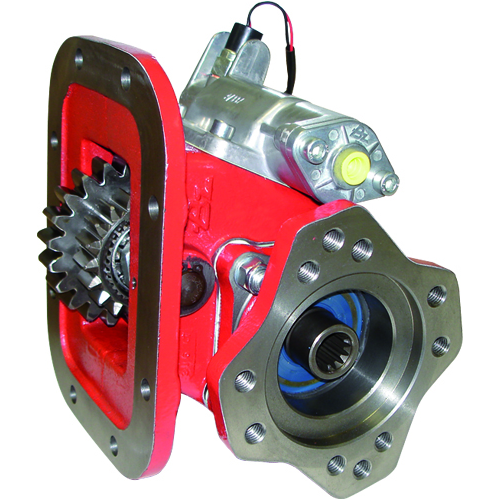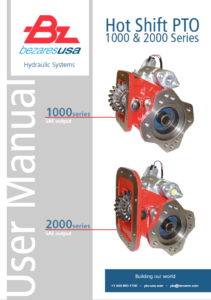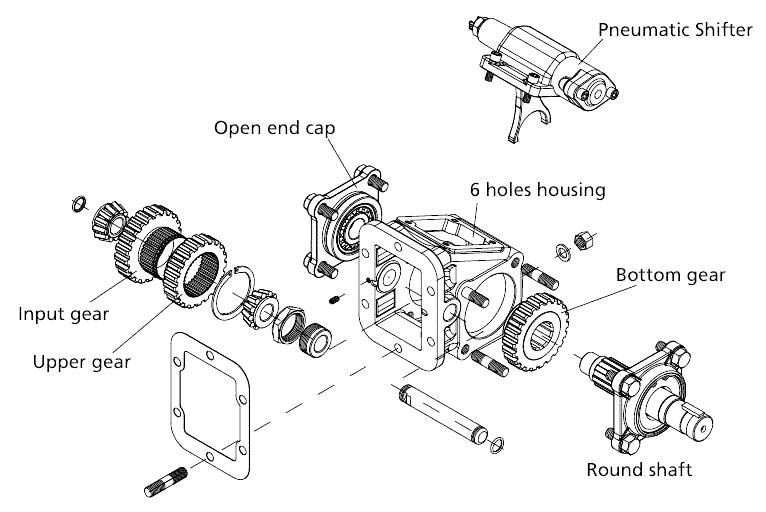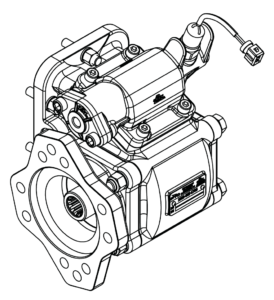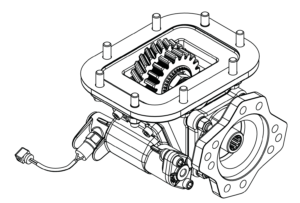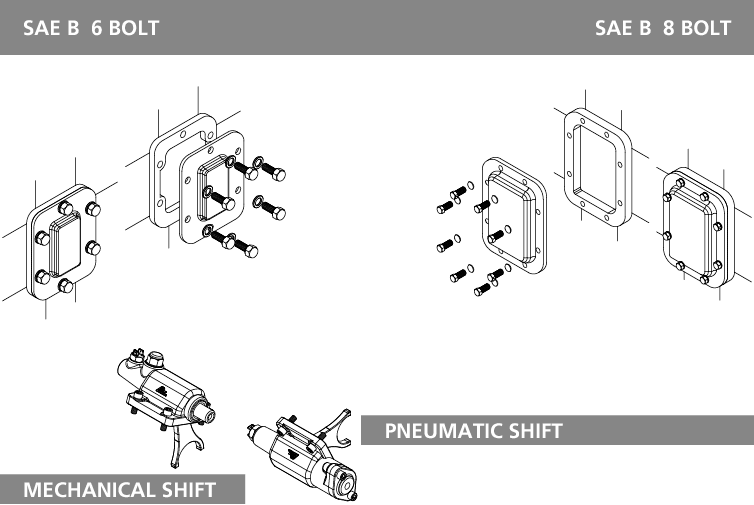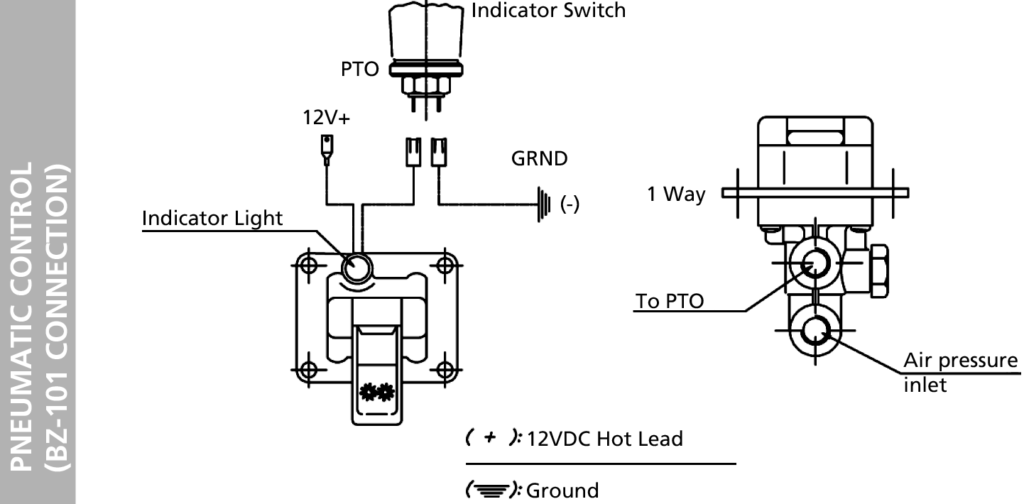Compatible with the most common transmissions in the market. The 1000 / 2000 series PTOs feature a wide range of input gear, ratio, output, and shifter options. All cast iron construction with large 12mm flange bolts to support some of the larger pumps in the market. Also available in a deep mount 1010 and 2010 series.
Features and benefits:
- Industry exclusive idler shaft with locking nut and snap ring.
- Deep gear tooth carburization for longer gear life.
- Larger flange mounting hardware provides additional support and reduces failures caused by heavy pumps – best in class.
- Industry leading Garlock gasket material provides better tear resistance and easier installation, with Viton o-ring material & shaft seals to prevent leaks.
- Symmetrical design allows for multiple configuration options and ease of installation.
- Simple and robust mechanical air shift operation.
- Quiet operational noise levels for an improved operator experience.
Competitive with:
Muncie TG8 and Chelsea 489
Torque ratings: up to 250 lb. ft.
Typical Applications: Dump Trucks and Trailers, Walking Floor, Low Boy, Vacuum Pumps, and more…..
CAUTION
TO PREVENT POSSIBLE INJURY:
- DO NOT go underneath the vehicle with the engine running.
- DO NOT attempt to work on an installed Power Take-Off with the engine running.
- DO NOT operate the controls of the Power Take-Off or other driven equipment from underneath the vehicle with the engine running.
- DO NOT operate the controls of the Power Take-Off or other driven equipment in any position that could result in getting caught in the moving machinery.
Make sure to block any moving or raised device that may injure a person working on or under the truck. A lever or its linkage may be accidentally moved causing movement of the device which could cause injury to a person near the device.
IMPORTANT
Because most of our Bezares Power Take–Offs and P.T.O. drive lines are sold through distributors, the product applications and the resulting degree of exposure to danger of the operators are beyond the knowledge and controls of BEZARES.
Therefore, the proper installation of the P.T.O. and its associated equipment, and the decisions of whether to install guards and/or warning signs shall be the responsibility of the designers or installers.
Since it is our major objective to show you how to get additional and more profitable miles from truck, tractor and trailer components, we want to provide you with information on the installation of 1000, and 2000 Series.
We all realize that an inadequate transmission will overwork any Power Take–Off in a very short period of time. In addition, a mismatched transmission/P.T.O. combination can result in unsatisfactory performance of the equipment right from the start.
Before you order new trucks be sure that you’re getting the right transmission/P.T.O. combination. It is of vital importance for efficient performance to have adequate power.
To help you select the proper type, size and design of P.T.O. it is advisable to discuss your specific requirements with a Bezares P.T.O. specialist. They know their products and Power Take–Offs. They can inform you about everything you need to know about power, at the right time, before you specify components.
Here are some of the questions that are relevant to the Proper Selections of a Transmission mounted Power Take–Offs.
- What is the make and model of your transmission?
- Which P.T.O. opening will be used?
- What accessory is to be driven?
- How much horsepower is required to drive the accessory?
- What is the required rotation of the P.T.O.?
- What is the required P.T.O. output shaft speed as a percent of engine speed?.
- What is the required method of shifting the P.T.O., mechanical or pneumatic?
Once all of the answer to these questions have been determined, a transmission mounted P.T.O. can be selected to meet the horsepower, speed and rotation that you require.
Check out our PTO Selection form at bezares.com/pto-selection-tool/
Having made the selection of a P.T.O., you are ready to start the installation.

Drain the oil from the transmission and the P.T.O. aperture cover plate.

Discard the cover plate and cover plate gasket then clean the aperture pad using a putty knife or wire brush.
NOTE: Stuff a rag in the aperture opening to prevent dirt from entering the transmission while you are cleaning it.

Using your hand, rock the P.T.O. driver gear in the transmission and the driven gear in the P.T.O. assembly. Rocking the gears provides two important factors:
A.- The amount of backlash that has been designed into each unit.

B.- Helps establishing the proper backlash when installing the P.T.O.

Install the proper studs (furnished with P.T.O.) in the P.T.O. aperture pad using a stud driver. Studs may have either interference fit threads (plain) or preapplied locking/sealing compound.
Tighten studs securely and torque to 17-19 Ft. lbs. (2.35-2.63 kg meters) for 6 bolt and 19-21 Ft. Lbs. (2.63-2.90 kg. meters) for 8 bolt.
Place the correct number of gaskets* over studs. Do not use paste between gaskets because you may want to add or subtract gasket to obtain proper backlash.
*For Endurant applications refer to Endurant section.
- When mounting a P.T.O. use gaskets between all mounting surfaces.
- Do not stack more than 3 gaskets together.
- Usually one thick gaskets 0.020” (0.50 mm) will be required.
- Remember the lubricant in the P.T.O. Therefore. At least one gaskets must always be used on either side filler blocks, adapter assemblies or adapter plates. More gaskets may be required when establishing proper backlash.

Secure P.T.O. to the transmission .
Gaskets are used as a guard against leaks under cap screw head.
NOTE: If holes in the P.T.O. aperture are not drilled through, discard the gaskets and replace them with lock washers.

Secure P.T.O. to the transmission .
Gaskets are used as a guard against leaks under cap screw head.
NOTE: If holes in the P.T.O. aperture are not drilled through, discard the gaskets and replace them with lock washers.

Caution

Overtightening of studs may damage stud and / or transmission threads.

Remove the P.T.O. shift housing and/or inspection plate.
Mount the dial indicator so that it registers movement of the input gear (driven gear) of the P.T.O.
NOTE: See drawing for proper location of dial indicator contact point. (Two common methods of dial indicators shown.)

Hold the P.T.O. driver gear in transmission with a screwdriver or bar and rock the P.T.O. input gear (driven gear) back and forth with your hand.
Note the total movement on the dial indicator.
Establish backlash at 0.006” – 0.012” (0.15 mm-0.30mm) by adding or subtracting gaskets.
General rule – A Bezares 0.010” gaskets will change backlash approx. 0.006”. A 0.020” gaskets changes backlash approx. 0.012”.
Replace the shift housing and/or inspection plate and retorque (4) four capscrews to 16-20 Ft. Lbs. (2.21-2.76 kg meters).
CAUTION
This vehicle is equipped with a Power Take-off.
Shut engine off before working on Power Take-Off or getting below vehicle.
Consult operating instructions before using.
POWER TAKE-OFF OPERATION VEHICLE STATIONARY.
- Mechanical Transmission.
A power take-off is, and should be, operated as an integral part of the main transmission.
Before shifting the power take-off into or our of gear, disengage the clutch and wait for transmission or P.T.O. gears to stop rotating. - Automatic transmission with manual shift P.T.O. (Includes air shift).
On automatic transmissions, the gears in the transmission turn when the transmission is in neutral, therefore, gear clashing will ocurr if the power take-off is shifted into gear at this time.
With converter driven gear:
• Shift transmission lever into any of drive positions. (This will stop the transmission gear from turning).
• Shift power take-off into gear.
Shift transmission into neutral. (This will start transmission gears turning.)
• Shift P.T.O. into gear before starting engine.
This procedure should eliminate gear clash.
IMPORTANT
Failures to follow proper shifting or operating sequences will result in premature P.T.O. failure with possible damage to other equipment.
Warning: Follow all local, state and federal safety precautions. Also adhere to all company safety procedures before, during and after PTO installation.
Note: Read the truck manufacture operation’s manual before starting the install.
Note: Read the truck up fitter document for your particular truck model and manufacturer before starting.
PACCAR INSTALLATION REQUIREMENTS
- When selecting and purchasing the new truck with an (PACCAR) Eaton Endurant transmission, ensure the factory installs the PTO Prep Kit.
- Ensure the transmission control module (TCM) has the J1939 feature enabled.
- The PACCAR PTO harness # P92-5075-2000 must also be ordered for the installation.
- Verify the transmission air tank is charged with appropriate pressure.
NAVISTAR INSTALLATION REQUIREMENTS
- Ensure the transmission control module (TCM) has the J1939 enabled
- Have the dealer order the listed below codes for the correct PTO prep package
- Order Sales code: 13WEW-wiring harness PTO
- Order Sales code: 13XAA- switch/air manifold
- Order Sales code: 13XAR- location-8 bolt bottom
Mechanical Installation (PACCAR and NAVISTAR)
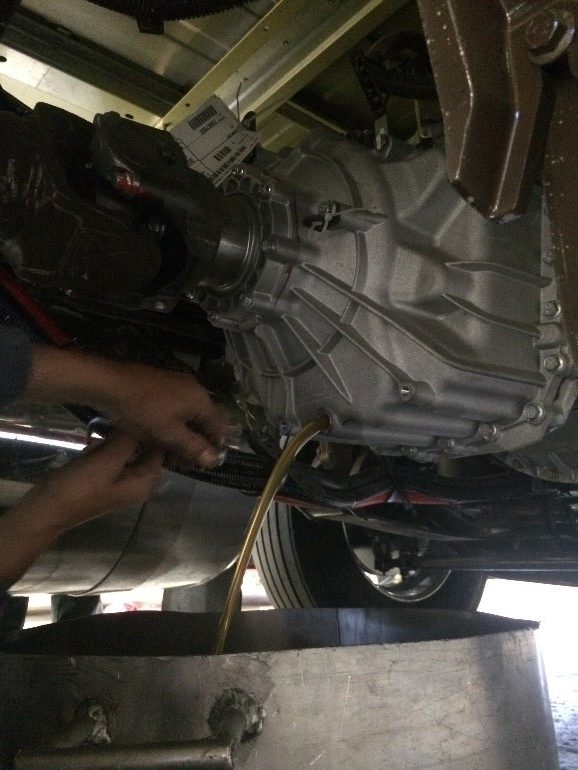
1. With the truck engine off, drain transmission fluid,
and dispose of properly.
2. Once all the fluid is drained, reinstall drain plug, tighten per OEM spec.
3. Locate the 8-bolt aperture plate on the bottom of the transmission. Place a container under the plate to catch remaining tranny fluid. Loosen all eight hex head bolts and discard appropriately.
4. Carefully remove the factory sealant, taking care not to scratch or gouge the sealing surface.

5. Wipe the 8-bolt aperture clean and ensure only metal is exposed
6. Open the Metric stud kit, install the studs into the transmission mounting pad.
7. Place the gasket over the studs up onto the transmission. The ribbed surface faces outward toward the installer. DO NOT shim – Only one (1) gasket is required.
8. Align the PTO mounting holes to the studs. Install washers, nuts and bolts.
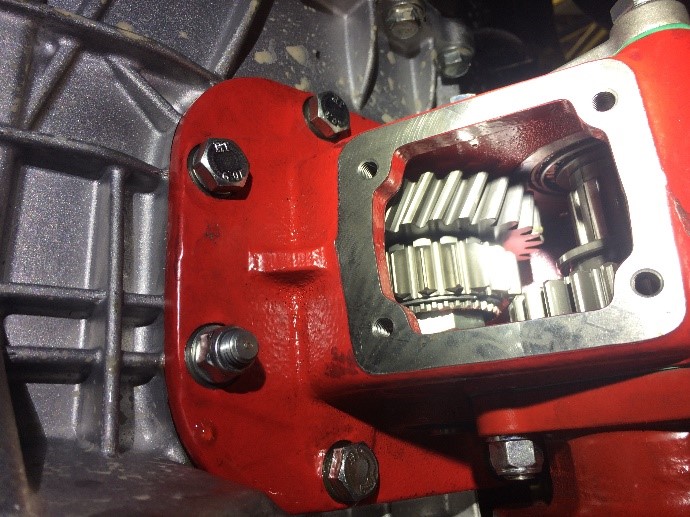
9. Ensure the PTO gear meshes with the transmission gear then tighten in a crosshatch pattern. Torque nuts to 45-50 lb. ft.
10. Mount and install the shifter gasket and shifter plate to PTO, input gear backlash is factory preset, so no adjustment required.
a. Shifter arm operation should be checked manually with shop air.
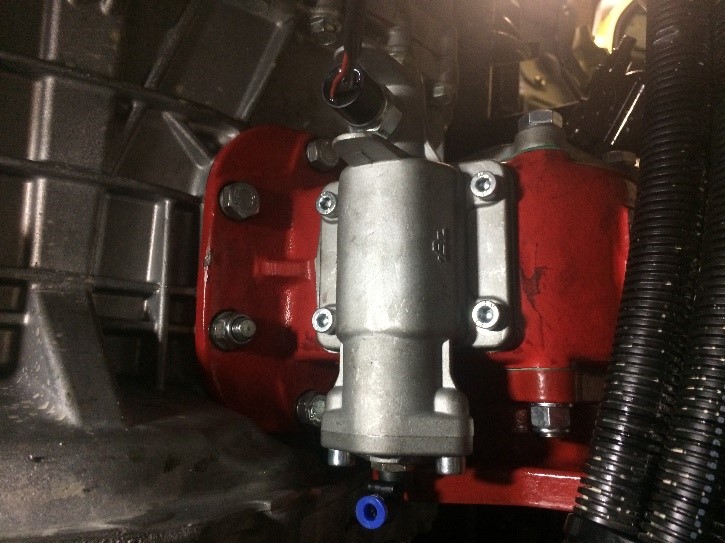
11. Install the indicator ball switch seal washer and switch on shifter plate – 30Nm / 22Lb.ft DO NOT OVER TIGHTEN.
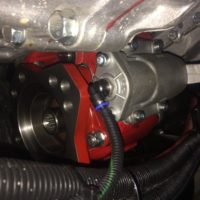
12. Install British Standard Pipe thread (BSP) ¼ inch push lock air fitting.
13. Fill tranny with fluid add extra to compensate for PTO, as needed, then verify. DO NOT OVER FILL.
Warning: Follow all local, state and federal safety precautions. Also adhere to all company safety procedures before, during and after PTO installation.
Note: Read the truck manufacture operation’s manual before starting the install.
Note: Read the truck up fitter document for your particular truck model and manufacturer before starting.
PACCAR INSTALLATION REQUIREMENTS
- When selecting and purchasing the new truck with an (PACCAR) Eaton Endurant transmission, ensure the factory installs the PTO Prep Kit.
- Ensure the transmission control module (TCM) has the J1939 feature enabled.
- The PACCAR PTO harness # P92-5075-2000 must also be ordered for the installation.
- Verify the transmission air tank is charged with appropriate pressure.
Electrical PACCAR Installation
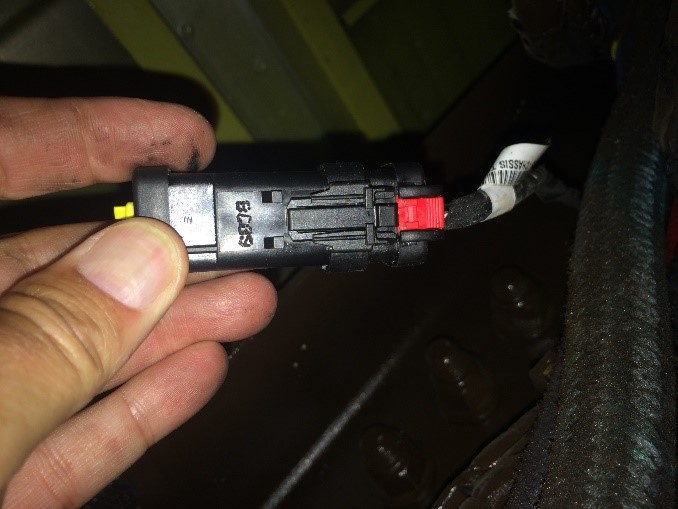
1. Locate the TCM connector, it is on driver side frame rail near top of transmission.
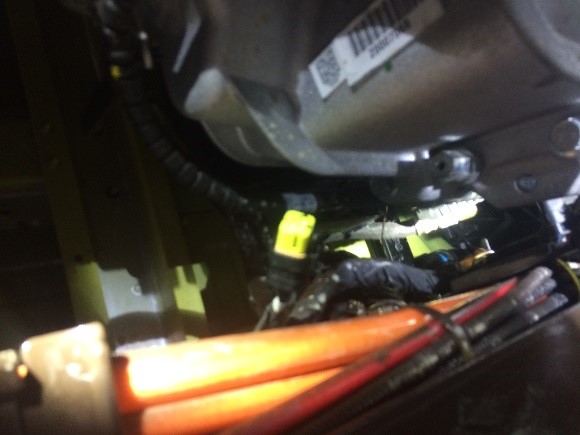
2. Remove end cover from sealed connector to expose pins.

3. Connect wire harness, P92-5075-2000, to connector.
ELECTRIC ENGAGED EQUIPMENT
At the left hand forward cab mount, P198 is available for PTO controls that are electrically engaged via ground.
– PTO PIN 2 completes the ground loop feedback and is part of PACCAR harness P92-5075-2000 which has two sections.
– This 4 Pin connector is terminated with second section wire connector with Metripak 280 single pin shown in picture 3 below
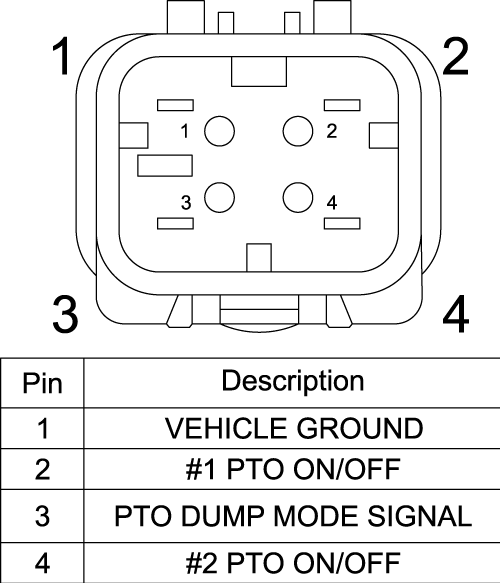
4. Cut off the single wire end and strip insulation off approx. ¾ inch. Length is determined at assembly.

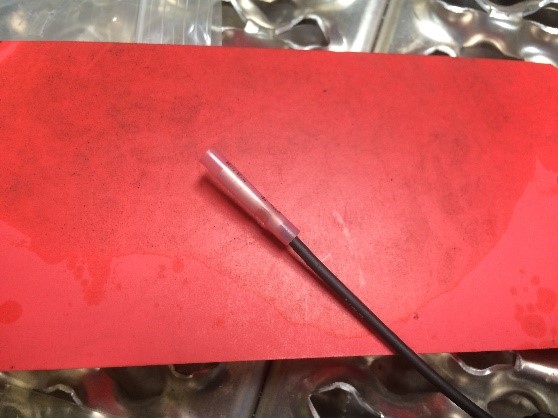
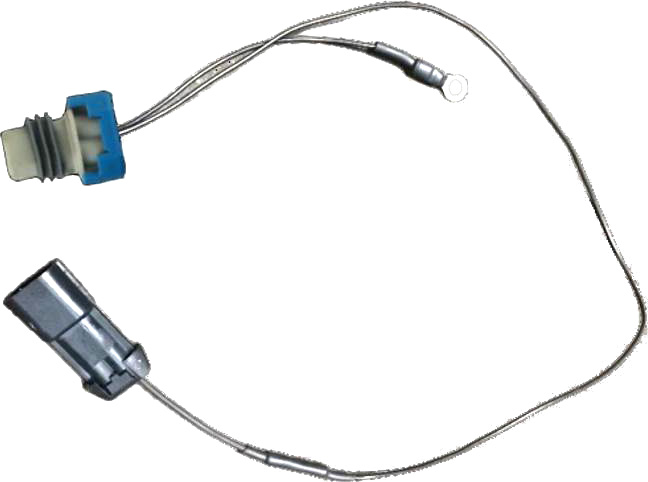
5. Modify the indicator ball switch connector wires same way, both leads, length is determined at assembly.
a. Using a butt splice, connect the bare BZ indicator ball switch wire to bare wire harness lead, cover with heat shrink.
b. Strip the other BZ wire end the affix it to appropriate electrical system ground. Battery negative (-) terminal is recommended.
6. Ensure all lose wires are secured from hot and rotating parts.
Warning: Follow all local, state and federal safety precautions. Also adhere to all company safety procedures before, during and after PTO installation.
Note: Read the truck manufacture operation’s manual before starting the install.
Note: Read the truck up fitter document for your particular truck model and manufacturer before starting.
NAVISTAR INSTALLATION REQUIREMENTS
- Ensure the transmission control module (TCM) has the J1939 enabled
- Have the dealer order the listed below codes for the correct PTO prep package
- Order Sales code: 13WEW-wiring harness PTO
- Order Sales code: 13XAA- switch/air manifold
- Order Sales code: 13XAR- location-8 bolt bottom
Electrical PACCAR Installation
1. There are two feed-back wire color combinations based on engine selection. If the LT tractor has the X15 Cummins, colors are green and purple. Purple is PTO # 1. If the LT tractor has the A26 engine there are two green wires. They are marked K88 and K88A. K88 is for PTO # 1 is also known as PTO A -8 bolt bottom
2. Connect one of the indicator switch leads to either X15 (purple) or A26 (green wire K88).The other lead goes to battery ground. That completes the feedback loop required for PTO # 1 operation

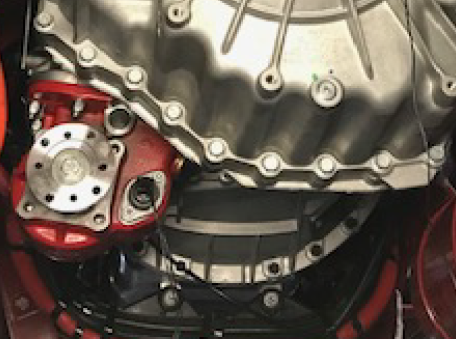
Warning: Follow all local, state and federal safety precautions. Also adhere to all company safety procedures before, during and after PTO installation.
Note: Read the truck manufacture operation’s manual before starting the install.
Note: Read the truck up fitter document for your particular truck model and manufacturer before starting.
PACCAR INSTALLATION REQUIREMENTS
- When selecting and purchasing the new truck with an (PACCAR) Eaton Endurant transmission, ensure the factory installs the PTO Prep Kit.
- Ensure the transmission control module (TCM) has the J1939 feature enabled.
- The PACCAR PTO harness # P92-5075-2000 must also be ordered for the installation.
- Verify the transmission air tank is charged with appropriate pressure.
Pneumatic PACCAR Installation
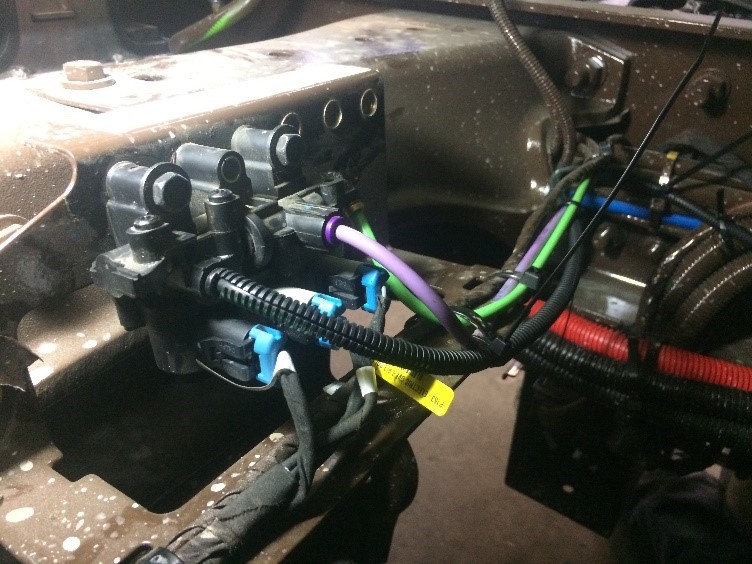
1. Locate air solenoid valve on truck frame cross member behind the cab.
2. Remove the dust cover from the solenoid air outlet port.
3. Use the appropriately rated ¼ inch airline and insert into valve output port
4. Route the ¼ inch airline to the PTO in such a way to keep from contacting or coming near hot and rotating parts.
5. Cut airline to require length and push on the air shift BSP shifting inlet port.
6. Secure the airline appropriately.
Warning: Follow all local, state and federal safety precautions. Also adhere to all company safety procedures before, during and after PTO installation.
Note: Read the truck manufacture operation’s manual before starting the install.
Note: Read the truck up fitter document for your particular truck model and manufacturer before starting.
NAVISTAR INSTALLATION REQUIREMENTS
- Ensure the transmission control module (TCM) has the J1939 enabled
- Have the dealer order the listed below codes for the correct PTO prep package
- Order Sales code: 13WEW-wiring harness PTO
- Order Sales code: 13XAA- switch/air manifold
- Order Sales code: 13XAR- location-8 bolt bottom
Pneumatic Navistar Installation
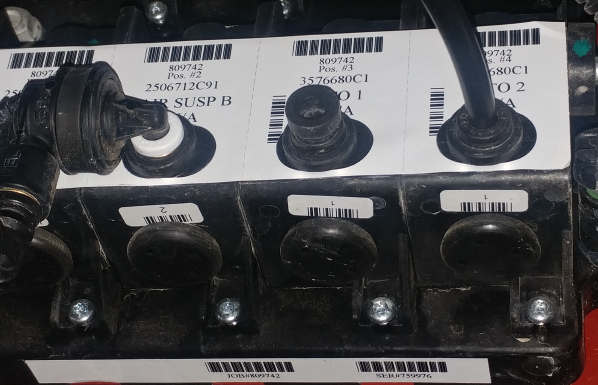
1. Locate the air solenoid manifold valve located on passenger side inner frame rail. There are two ¼ inch push in solenoids marked PTO # 1 and PTO # 2. Plug the airline from 8 bolt PTO into solenoid marked PTO # 1
2. PTO # 1 is also PTO A. NOTE! PTO, # 2 is also PTO B. PTO B is for rear countershaft only
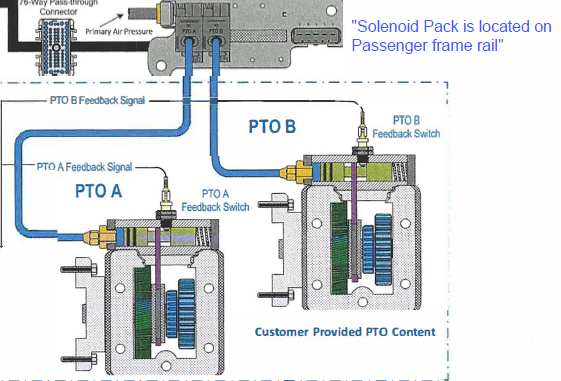
3. Insert ¼ inch airline into air manifold marked PTO # 1. Cut airline to fit and insert in ¼ inch air bung on PTO # 1 or PTO A
1. Read and follow the truck’s manual before attempting to run PTO
2. Verify tranny has adequate fluid and extra fluid to compensate for PTO (DO NOT OVER FILL)
3. Follow all company, federal, state and local safety procedures and guidelines.
4. Apply parking brake.
5. Truck must be in neutral.
6. Insert key in ignition.
7. Verify no one is under vehicle or near any rotating parts – ALL CLEAR!
8. Start engine, the PTO is not engaged and the output shaft is not turning.
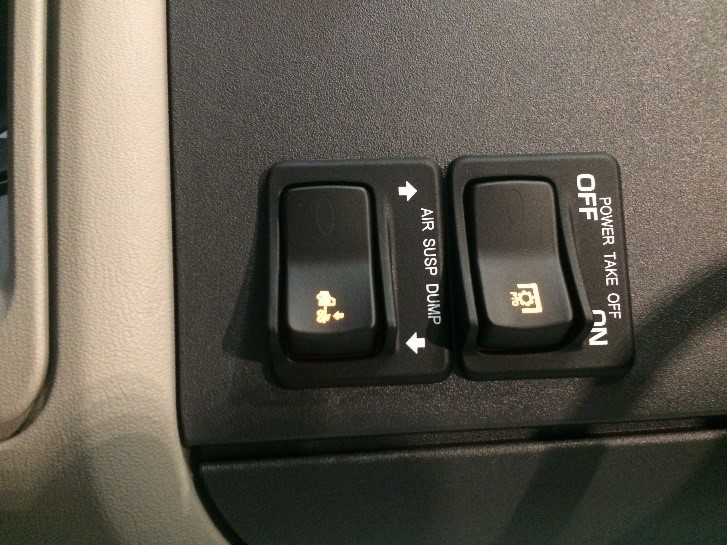
9. Start engine, the PTO is not engaged and the output shaft is not turning.
10. The PTO now shifts, and the output shaft is rotating. There may be some audible gear noise, this is normal and does not diminish the form, fit of function.
11. Depress the PTO rocker switch to disengage PTO and discontinue output shaft rotation.
1. Check for leaks, fix any if found.
2. After truck warms up check all hardware for proper torque, tighten as needed.
3. Check all wire connections, ensure they are correctly installed and away from heat and rotating parts, fix and repair as needed.
4. Check the airline, ensure it is correctly installed and away from heat and rotating parts, fix and repair as needed.
PTO Troubleshooting
| wdt_ID | PROBLEM | REASON | CORRECTIVE ACTION | PREVENTION |
|---|---|---|---|---|
| 1 | PTO is Noisy (whines) | -insufficient mounting backlash | -remount PTO adding gaskets to achieve backlash of .006-.012” | -check and set proper backlash |
| 2 | PTO is Noisy (rattles) | -excessive mounting backlash | -remount PTO removing gaskets to achieve backlash of .006-.012” | -check and set proper backlash |
| 3 | PTO is Noisy (clicks) | -damaged/worn gear tooth | -replace damaged/worn gear | -check and set proper backlash |
| 4 | -overloading PTO | -reduce load | -review application | |
| 5 | Leaking Shaft Seal | -dirt under seal | -replace seal | -preventive maintenance |
| 6 | -damaged seal or cover | -replace seal or cover | -preventive maintenance | |
| 7 | -improperly seated seal | -replace seal | -preventive maintenance | |
| 8 | -worn shaft at seal area | -replace output shaft/seal | -preventive maintenance | |
| 9 | Leaking Output Flange | -torn flange gasket | -replace gasket | -preventive maintenance |
| 10 | -loose flange bolts | -properly torque flange bolts | -preventive maintenance | |
| 11 | -direct mount pump improperly supported | -install pump support brackets | -review application requirements | |
| 12 | Leaking Mounting Face | -torn mounting gasket | -replace mounting gasket | -preventative maintenance |
| 13 | -cracked mounting pad | -replace housing/set backlash | -proper mounting torque | |
| 14 | -broken mounting shim | -replace mounting shim/set backlash | -preventative maintenance | |
| 15 | -improper gaskets/shim used | -replace gaskets/shim | -ensure proper gaskets/shim are used | |
| 16 | Leaking Bearing/Shift | -torn gasket | -replace gasket | -preventive maintenance |
| 17 | COVER | -loose cap screws | -properly torque cap screws | -preventive maintenance |
| 18 | Cracked Housing | -insufficient backlash | -replace housing/set backlash | -check and set proper backlash |
| 19 | -unsupported direct mount pump | -replace housing/attach pump support bracket | -review application | |
| 20 | -over torque condition | -replace housing | -review application | |
| 21 | -foreign object between gears | -replace housing/gears | -preventive maintenance | |
| 22 | -impact with external object | -replace housing | -install protection/avoid impacts | |
| 23 | -shock load/cold relief pressure | -replace housing | -allow oil to warm before loading | |
| 24 | PTO Failure | -broken/damaged parts | -inspect/replace damaged parts | -preventive maintenance |
| 25 | -driveshaft problem | -check phasing, angle, and slip of driveshaft | -preventive maintenance | |
| 26 | -worn/damaged driveshaft components | -repair/replace driveshaft | -preventive maintenance | |
| 27 | PTO Does Not Engage/ Disengage (wire shift) | -worn/damaged shift control | -repair/replace components | -preventive maintenance |
| 28 | -loose/missing linkage/attachments | -adjust/replace components | -preventive maintenance | |
| 29 | -worn/damaged cable | -repair/replace components | -preventive maintenance | |
| 30 | PTO Does Not Engage/ Disengage (air shift) | -lack of air pressure | -ensure pressure exceeds 100psi/governor cut-in | -preventive maintenance |
| 31 | -shifter damaged | -replace shifter | -install protection/avoid impacts | |
| 32 | -shifter piston leaking | -replace shifter seals | -preventive maintenance | |
| 33 | -shifter piston does not move | -check for contaminates in air cylinder | -preventive maintenance | |
| 34 | -contaminated air lines | -clean air systems | -preventive maintenance | |
| 35 | -worn/damaged shift control | -repair/replace components | -preventive maintenance | |
| 36 | PTO Does Not Engage/ Disengage (all) | -shift fork not in shift collar | -check/reinstall shift cover | -preventive maintenance |
| 37 | -internal gears do not mesh | -check for internal debris/damage | -preventive maintenance | |
| 38 | -improper shifting | -adjust vehicle clutch | -review transmission manual |

